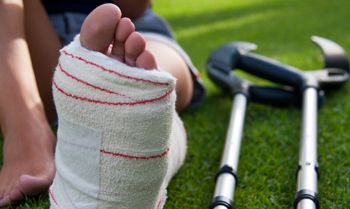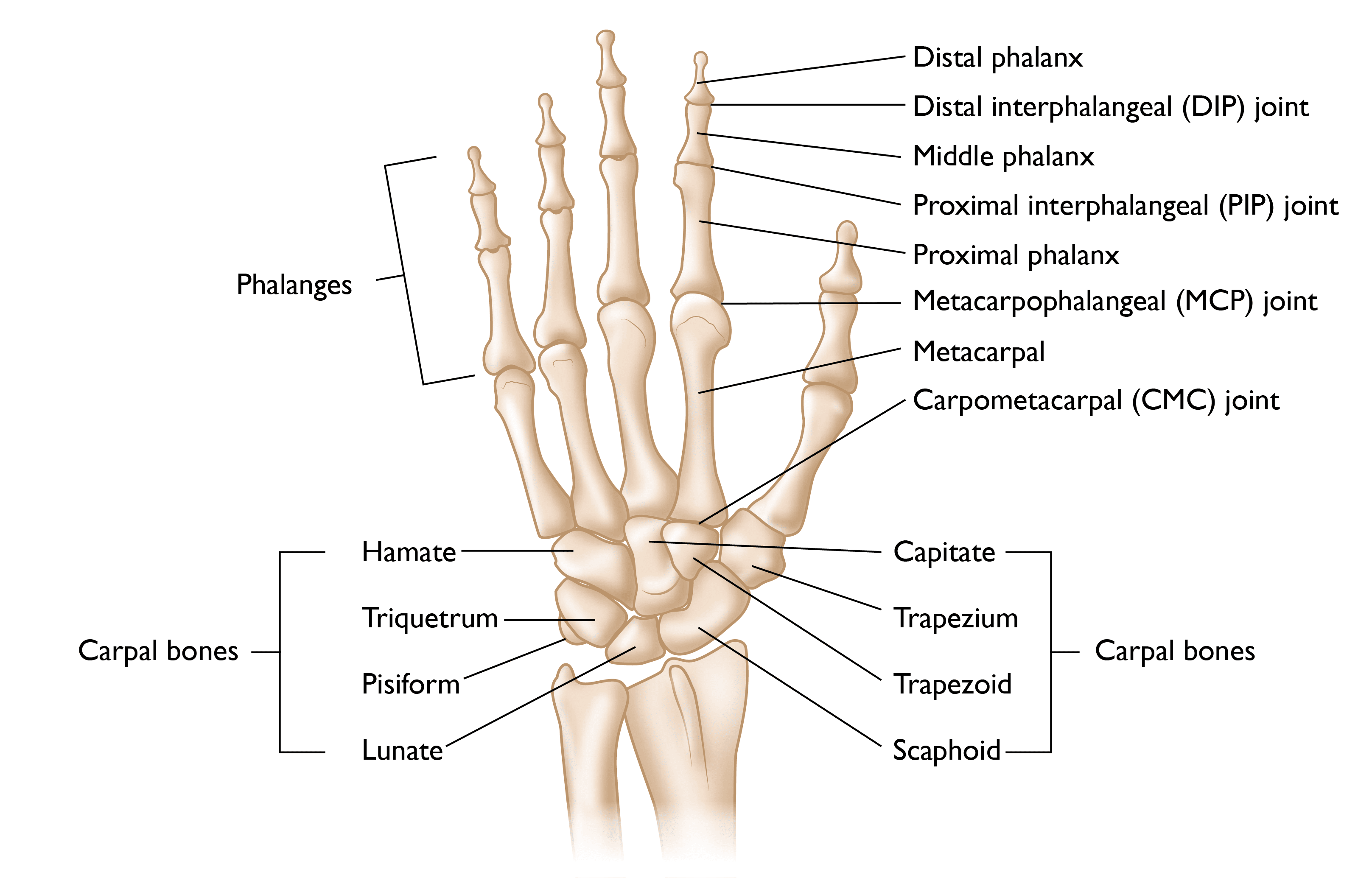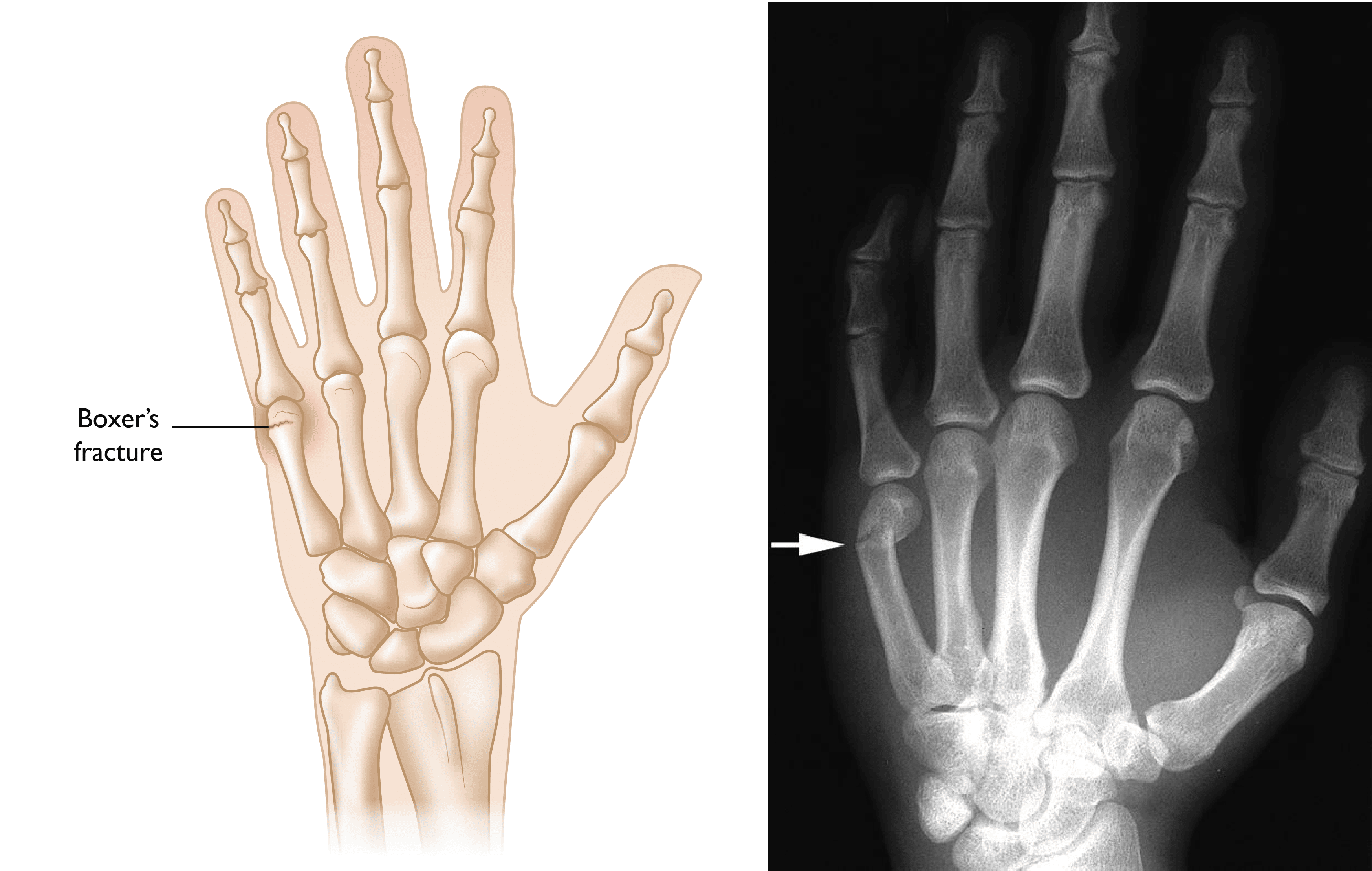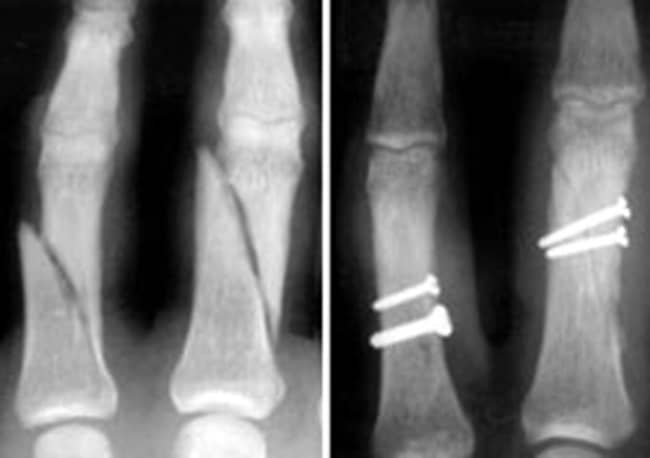Diseases & Conditions
Finger Fractures
Although the bones in the fingers are small, a broken (fractured) finger is not a minor injury.
The bones in a normal finger line up precisely. They let you perform many specialized functions, such as grasping a pen, playing an instrument, or typing on a computer. When you fracture a finger bone, it can cause dysfunction affecting your entire hand. Without appropriate treatment, your broken finger may end up misaligned, stiff, or painful.
Anatomy
Your hand consists of 27 bones:
- Eight bones in your wrist (carpals)
- Five bones in the palm of your hand (metacarpals)
- 14 bones in your fingers (phalanges)
These bones are connected by joints:
- The carpometacarpal (CMC) joint is where a digit's metacarpal connects to the wrist. The thumb CMC joint allows for quite a bit of motion, enabling you to put your thumb in a variety of positions for grasping. There is some motion in the CMC joints of the little and ring fingers and very little motion in the CMC joints of the middle and index fingers.
- The metacarpophalangeal (MCP) joint is where your finger connects to the metacarpal
- The interphalangeal (IP) joints are the joints within your fingers. Combined, the MCP and IP joints allow you to straighten your fingers and make a fist.
Cause
Generally, a fractured finger occurs as the result of an injury to the hand. You can fracture a finger when:
- You slam your fingers in a door.
- You put out your hand to break a fall.
- Your finger jams while trying to catch a ball.
- You have an accident while working with a power saw, drill, or other tools.
- Your hand strikes a hard object. Fractures of the metacarpal bone that attaches your little finger to your hand, which account for about one-third of all hand fractures in adults, are typically caused by a punching force (these are known as "boxer's fractures").
Symptoms
- Swelling of the fracture site
- Tenderness at the fracture site
- Bruising at the fracture site
- Inability to move the injured finger completely
- Deformity of the injured finger
Doctor Examination
If you think you fractured your finger, immediately tell your doctor exactly what happened and when it happened. Your doctor must determine not only which bone(s) you fractured, but also how the bone(s) broke.
Bones can break in several ways:
- Straight across the bone
- In a spiral pattern
- Into several pieces
- Shattered completely
Your doctor may want to see how your fingers line up when you extend your hand or make a fist. Does any finger overlap with its neighbor? Does the injured finger angle in the wrong direction? Does the injured finger look too short?
Your doctor will obtain X-rays and sometimes advanced imaging tests, such as a computed tomography (CT) scan, to better understand the fracture and how it should be treated.
Your doctor will also look for injuries to other nearby structures. It is not uncommon for a finger that is fractured to also have injuries to tendons, nerves, and/or ligaments. These injuries may need to be treated along with the broken bone(s) to ensure a good outcome.
Treatment
Nonsurgical Treatment
For fractures that are displaced, or not lined up correctly:
- Your doctor will likely put your broken bone back into place; often, this can be done without surgery.
- You may get a splint or cast to hold your finger straight and protect it from further injury while it heals. Sometimes your doctor may splint the fingers next to the fractured one to provide additional support. Your doctor will tell you how long to wear the splint. Usually, a splint on a fractured finger is worn for about 3 weeks.
- You may need more X-rays over this time so that your doctor can monitor the progress of your finger as it heals.
- After the fracture heals, it will likely be stiff from not moving for several weeks. Therapy may be necessary to help get motion back in the finger.
Surgical Treatment
Depending on the type and severity of the fracture, you may need surgery to put the bones into alignment and keep them there while they heal.
- Small devices, such as pins, screws, plates, or wires, will be used to hold your fractured bones together. Sometimes, these devices can stay in for life, and sometimes they need to be removed after the fracture heals.
- Depending on the strength of the repair, you may be able to move the finger soon after surgery to avoid stiffness.
Fractures that involve the CMC, MCP, or IP joints are particularly worrisome and very often require surgery. When these fractures are not treated promptly and adequately, they can lead to substantial finger dysfunction and long-term consequences, such as arthritis.
Finger fractures requiring surgery often need therapy after the procedure to help prevent or correct stiffness.
Rehabilitation
You may begin using your hand again as soon as your doctor determines it is OK to move your finger. Doing simple rehabilitation exercises each day will help reduce the finger's stiffness and swelling. You may be required to see a hand therapist to assist you in these exercises.
Outcomes
Outcomes following the treatment of finger fractures vary:
- Some simple fractures are easily treated, and treatment results in excellent function.
- Some more catastrophic injuries (e.g., a gunshot to the finger) — in which multiple structures (such as tendons, nerves, and/or ligaments) are involved — result in stiff and poorly functioning fingers even with the best treatments. In some cases, a second or third surgery may be needed to remove hardware once the bone is healed or to free up tendons that have scarred to the fracture site.
If you suspect you have a finger fracture, seek treatment as soon as possible. The sooner a fracture is addressed by a doctor, the better the outcome will likely be.
Last Reviewed
June 2022
Contributed and/or Updated by
Peer-Reviewed by
AAOS does not endorse any treatments, procedures, products, or physicians referenced herein. This information is provided as an educational service and is not intended to serve as medical advice. Anyone seeking specific orthopaedic advice or assistance should consult his or her orthopaedic surgeon, or locate one in your area through the AAOS Find an Orthopaedist program on this website.











